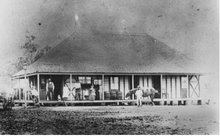Immediately after graduation Nen worked for Dorman, Long and Company as a draftsperson on their big project of the 1920s – the Sydney Harbour Bridge. Nen then moved to Cairns for a short time and then to Brisbane where she worked for the Workers' Dwellings Branch of the State Advances Corporation from November 1925 to early 1929. The main purpose of the State Advances Corporation was to design and build simple, affordable housing – what we know as public housing.
Nen had always been interested in craft, studying and making jewellery and other things. While in Brisbane she studied pottery with LJ Harvey from 1929 to 1932. She returned to Sydney and set up a commercial pottery with her brother Robert. This pottery made simple, organic stoneware drawing on ideas of nature and elegant, simple design. The pottery was in many ways ahead of its time. The aesthetic of the time demanded fine bone china, not what was seen as “coarse” stoneware. It was a good livelihood for Nen and Bob, but it was never a raging success. In stark contrast, the pottery is now avidly collected with certain rare pieces having several thousand dollar price tags. The more common vases do a brisk trade on EBay.
I have always thought that Nen might have been disappointed in the technical demands of architecture – that it didn’t satisfy her aesthetic needs. If you look at her drawings and designs, they exhibit great artistry. A combination of this artistic drive and the difficulty of always being the pioneer in a male-dominated field, may have been behind her shift from architect to potter.
From family tales, Nen very much saw herself as the artistic driving force of the pottery, with Bob providing the technical know-how. Ironically, Bob had great skill with sculpture and made all the molds for their production line. Nen concentrated on throwing and wheel work. All the pottery produced at their Epping pottery was signed collaboratively. However, Nen continued to make experimental pieces and exhibit through the NSW Society of Arts and Crafts. These pieces she signed on the base with her own monogram. In 1951 she won the Society's Elizabeth Soderberg Memorial Award for pottery.
McCredie Pottery is represented in five public collections in Australia: the National Gallery of Australia, the Art Gallery of New South Wales, the Powerhouse Museum, Sydney, the Art Gallery of South Australia and Shepparton Art Gallery.
Yesterday, I had a day off and we headed for Brisbane for the day. One of our goals was to hunt down the heritage listed Uanda, Nen’s only publicly known building still existing in Queensland. The state heritage register lists it as her only known existing work, but my grandfather’s (Bob of pottery fame) house in Sydney, still stands, as do several other Sydney houses.
 Driving along a wet Wilston street, I pointed out a particularly attractive house. “Oh, I like that one.” And yes, it was Uanda, newly restored albeit with an ugly extension out the back. I suspect the extension was allowed because it doesn’t impinge on the body of the house – like a box attached to an ornament. And the name is no longer on the house. But I was thrilled to see Nen’s work surviving so beautifully to today.
Driving along a wet Wilston street, I pointed out a particularly attractive house. “Oh, I like that one.” And yes, it was Uanda, newly restored albeit with an ugly extension out the back. I suspect the extension was allowed because it doesn’t impinge on the body of the house – like a box attached to an ornament. And the name is no longer on the house. But I was thrilled to see Nen’s work surviving so beautifully to today. The other thing that I love is that the house was designed and built in 1928, which makes it about the same age as our house. I like to think of Nen being in Brisbane while our house was built. Bob was very much the younger brother and we have a palm stand that he built in 1928 while still at school. I love the sense of connection to the past that these things bring.

1 comment:
This is a great story. I am interested in the house, its history and the architect.
Thanks for posting.
Trevor
blog - Your Brisbane: Past and Present
Post a Comment